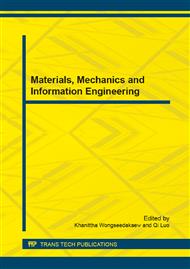p.47
p.52
p.58
p.64
p.67
p.73
p.79
p.83
p.89
An Investigation about Welding Parameters of Polypropylene Matrix Composite
Abstract:
This paper presents an experimental investigation of heated tool welding of polypropylene matrix composite. The goals of this paper are to investigate the issues of local changes of welding strength that depends on heating time. For experimental procedure, specimens were injection molded as ISO tensile test specimens and matrix was reinforced by organic and inorganic materials. In addition, welding of specimens was carried out by non-contact heated tool butt welding process. Within the range of the weld process parameters were investigated, the highest weld strength dependent on heating time was achieved of the order of 94% to the base strength of the material. And then these specimen’s maximum welding strengths and energy at break point properties that were depend on heating time have been compared.
Info:
Periodical:
Pages:
67-72
Citation:
Online since:
January 2015
Authors:
Price:
Сopyright:
© 2015 Trans Tech Publications Ltd. All Rights Reserved
Share:
Citation:


